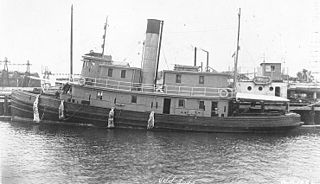Ship commissioning is the act or ceremony of placing a ship in active service and may be regarded as a particular application of the general concepts and practices of project commissioning. The term is most commonly applied to placing a warship in active duty with its country's military forces. The ceremonies involved are often rooted in centuries-old naval tradition.
USS Grampus may refer to:
USS Yuma has been the name of five ships of the United States Navy. The name is taken after the Yuma tribe of Arizona.
Four ships of the United States Navy have been named Canonicus for Canonicus, a chief of the Narragansett Indians, who befriended Roger Williams, and presented him with a large tract of land for the Rhode Island colony.
The first USS Saco was a gunboat in the United States Navy during the American Civil War.

The second USS Saco was a yard tug in the United States Navy during the 1920s.
Three ships in the United States Navy have been named USS Cayuga for one of the six Iroquois tribes.
USS Wateree may refer to the following ships of the United States Navy:
USS Zouave (1861) was a steamer acquired by the Union Navy during the American Civil War. She was needed by the Navy to be part of the fleet of ships to prevent blockade runners from entering ports in the Confederacy.

The USS Harvest Moon was a steam operated gunboat acquired by the Union Navy during the American Civil War. She was used by the Navy to patrol navigable waterways of the Confederacy to prevent the South from trading with other countries.
USS Daisy may refer to one of the following United States Navy ships:

USS Thomas Freeborn was a steam tug acquired by the Union Navy during the American Civil War. She was used by the Navy as a gunboat to patrol navigable waterways of the Confederacy to prevent the South from trading with other countries.

USS Blue Light was a steam tug built for the United States Navy during the American Civil War. She was used by the Union Navy as an ordnance tugboat in support of the Union Navy blockade of Confederate waterways.
USS Osceola has been the name of more than one United States Navy ship, and may refer to:
USS Althea (1863) was a screw steamer acquired by the Union Navy during the American Civil War. The Union Navy used her as a tugboat, a torpedo boat, and as a ship's tender in support of the Union Navy blockade of Confederate waterways.
USS Guard may refer to the following ships of the United States Navy:
USS Port Fire (1863) was a steamer commissioned by the Union Navy during the American Civil War.
USS Nina was a United States Navy steamer commissioned in 1866. She served in a variety of roles — as a tug, torpedo boat, torpedo boat tender, salvage ship, supply ship, and submarine tender — before she sank in a storm in 1910.

Saco (YTB-796) was a United States Navy Natick-class large harbor tug named for Saco, Maine. She was the third navy ship to bear the name.

The Bagaduce class was a class of United States Navy fleet tugs. The first ship of the class, USS Bagaduce (AT-21) was laid down on 16 July 1918 at Buffalo, New York, by the Ferguson Steel and Iron Company. She was briefly named Ammonoosuc in February 1919, renamed Bagaduce on 24 February 1919, launched 5 April 1919, and commissioned at Buffalo on 18 September 1919. The Bagaduce was constructed as part of the World War I shipbuilding program, and was the first of 19 new steel tugs designed to serve as minesweepers and conduct heavy-duty towing work at navy yards.
This page is based on this
Wikipedia article Text is available under the
CC BY-SA 4.0 license; additional terms may apply.
Images, videos and audio are available under their respective licenses.





